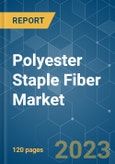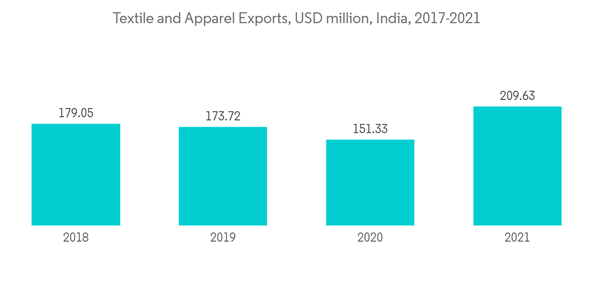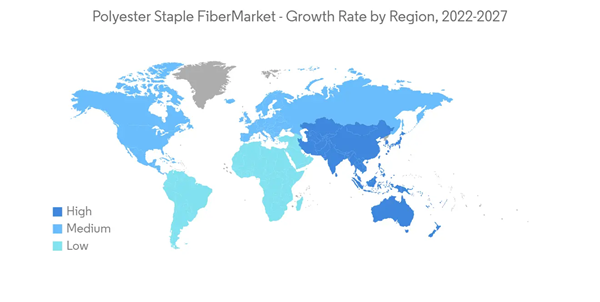The polyester staple fiber market is expected to register a CAGR of over 4% during the forecast period.
Polyester staple fiber is commonly used in spinning and non-woven weaving. PSF is mostly utilized in cushion and couch fiber fillings. It is also used in polyester spun yarn production, which is subsequently knitted or woven into textiles.
This product will be delivered within 2 business days.
Polyester staple fiber is commonly used in spinning and non-woven weaving. PSF is mostly utilized in cushion and couch fiber fillings. It is also used in polyester spun yarn production, which is subsequently knitted or woven into textiles.
Key Highlights
- Over the medium term, the significant factors driving the market studied are the increasing demand from the textile industry for making apparel and the rising demand from the home furnishing segment. Growing awareness regarding recycled polyester staple fiber due to increasing environmental concerns is expected to offer various lucrative opportunities for market growth.
- By application, the apparel segment is expected to dominate the market due to the increase in the usage of polyester staple fiber to make apparel, as it is cheaper than cotton.
- On the flip side, stringent legal and political regulations on manufacturers are restraining the polyester staple fiber market.
- The Asia-Pacific region dominated the polyester staple fiber market globally, with enormous consumption from countries like China and India.
Polyester Staple Fiber (PSF) Market Trends
Increasing Demand from the Textile Segment
- Polyester staple fiber (PSF) is a synthetic artificial fiber made directly from purified terephthalic acid (PTA) and mono ethylene glycol (MEG), or polyethylene terephthalate (PET)/polyester waste, or recycled post-consumer PET bottle flakes.
- The increasing polyester staple fiber use in sportswear, activewear, etc., is driving its demand in the garment industry, propelling the market forward. The polyester staple fiber market is also benefiting from a surge in its use as a cotton alternative due to cost, thinness, and availability in various styles and colors.
- In addition, various high-tech polyester staple fibers have antibacterial qualities and provide better protection against odor and diseases. The polyester staple fiber market is predicted to grow due to these characteristics throughout the forecast period.
- The textile industry in India is one of the country's oldest and most crucial sectors. It substantially contributes to the Indian economy, accounting for around 14% of industrial production. After China, India is the world's second-largest manufacturer of textiles. In 2021, India exported USD 209.63 million in textiles and apparel, a 30% increase over the previous year, according to the International Trade Administration.
- Bangladesh's textile industry is one of the most critical areas of the country's economy, accounting for more than 80% of total exports. According to the International Trade Administration, Bangladesh exported USD 40.49 million in textiles and apparel clothing in 2021.
- The market is expected to multiply over the forecast period due to all the abovementioned factors.
The Asia-Pacific Region to Dominate the Market
- The Asia-Pacific region is expected to dominate the polyester staple fiber market during the forecast period.
- In countries like China, India, and South Korea, owing to an increase in demand from various applications in apparel, automotive, and home furnishing, coupled with rising population, changing lifestyles, economic growth, and growing per capita income, the demand for polyester staple fiber is increasing.
- The textile industry in the Asia-Pacific area is one of the world's largest and most important. The region is projected to account for more than 60% of worldwide textile output. The sector is highly competitive and significantly grew over the last decade due to increased demand from domestic and foreign markets.
- The business is characterized by many small-scale producers, with the most prominent participants being China, India, and Bangladesh. Because of their low labor costs and easy access to raw materials, many countries' textile industries have increased. Furthermore, the region saw an increase in international investment, mainly from Japan and South Korea, which aided in driving innovation and technological advancement.
- China, India, and Bangladesh combinedly exported USD 1.098 billion of textiles and apparel clothing to the rest of the world in 2021.
- The rising demand from the home furnishing segment for making pillows, sofas, bed sheets, carpets, and rugs is increasing the demand for polyester staple fiber in the region and, thus, propelling its market.
- Sustainable fashion made from recycled and ecologically friendly items such as polyester made staple fiber more popular among customers. The polyester staple fiber industry is boosted by sustainable clothes availability in vivid colors, fashionable designs, and appealing patterns.
- According to the Ministry of Textiles India, the country is the world's sixth-largest export of textiles and apparel. Owing to the significant PSF applications in the textile industry, the demand in the market is expected to increase in the years to come.
- Owing to the abovementioned factors, the region's demand for polyester staple fiber is estimated to grow during the forecast period.
Polyester Staple Fiber (PSF) Market Competitor Analysis
The polyester staple fiber (PSF) market is highly fragmented, with the top five players accounting for a minimal market share. Some of the key companies in the market include Toray Industries Inc., Alpek SAB de CV, Reliance Industries Limited, Bombay Dyeing, and W. Barnet GmbH & Co. KG.Additional benefits of purchasing the report:
- The market estimate (ME) sheet in Excel format
- 3 months of analyst support
This product will be delivered within 2 business days.
Table of Contents
1 INTRODUCTION1.1 Study Assumptions
1.2 Scope of the Study
2 RESEARCH METHODOLOGY
3 EXECUTIVE SUMMARY
4 MARKET DYNAMICS
4.1 Drivers
4.1.1 Increasing Demand from the Textile Industry
4.1.2 Rising Demand from the Home Furnishing Segment
4.2 Restraints
4.2.1 Stringent Legal and Political Regulations
4.3 Industry Value Chain Analysis
4.4 Porter's Five Forces Analysis
4.4.1 Bargaining Power of Suppliers
4.4.2 Bargaining Power of Consumers
4.4.3 Threat of New Entrants
4.4.4 Threat of Substitute Products and Services
4.4.5 Degree of Competition
5 MARKET SEGMENTATION
5.1 Product Type
5.1.1 Solid
5.1.2 Hollow
5.2 Origin
5.2.1 Virgin
5.2.2 Blended
5.2.3 Recycled
5.3 Application
5.3.1 Textile
5.3.2 Home Furnishing
5.3.3 Automotive
5.3.4 Filtration
5.3.5 Construction
5.3.6 Other Applications
5.4 Geography
5.4.1 Asia-Pacific
5.4.1.1 China
5.4.1.2 India
5.4.1.3 Japan
5.4.1.4 South Korea
5.4.1.5 Rest of Asia-Pacific
5.4.2 North America
5.4.2.1 United States
5.4.2.2 Canada
5.4.2.3 Mexico
5.4.3 Europe
5.4.3.1 Germany
5.4.3.2 United Kingdom
5.4.3.3 Italy
5.4.3.4 France
5.4.3.5 Rest of Europe
5.4.4 South America
5.4.4.1 Brazil
5.4.4.2 Argentina
5.4.4.3 Rest of South America
5.4.5 Middle-East and Africa
5.4.5.1 Saudi Arabia
5.4.5.2 South Africa
5.4.5.3 Rest of Middle-East and Africa
6 COMPETITIVE LANDSCAPE
6.1 Mergers and Acquisitions, Joint Ventures, Collaborations, and Agreements
6.2 Market Share (%)/Ranking Analysis**
6.3 Strategies Adopted by Leading Players
6.4 Company Profiles
6.4.1 Alpek SAB de CV
6.4.2 Bombay Dyeing
6.4.3 Diyou Fibre (M) Sdn Bhd
6.4.4 Far Eastern Group
6.4.5 Huvis
6.4.6 Indorama Ventures Public Company Limited
6.4.7 Komal Fibres
6.4.8 Nirmal Fibres (P) Ltd
6.4.9 Reliance Industries Limited
6.4.10 RUDRA FIBRE
6.4.11 Shubhalakshmi Polyesters Ltd
6.4.12 Tongkun Group Co. Ltd
6.4.13 TORAY INDUSTRIES INC.
6.4.14 W. Barnet GmbH & Co. KG
6.4.15 XINDA Corp.
6.4.16 ZHEJIANG BORETECH ENVIRONMENTAL ENGINEERING CO. LTD
6.4.17 Zhejiang Hengyi Group Co. Ltd
7 MARKET OPPORTUNITIES AND FUTURE TRENDS
7.1 Growing Awareness Regarding Recycled Polyester Staple Fiber
7.2 Other Opportunities
Companies Mentioned (Partial List)
A selection of companies mentioned in this report includes, but is not limited to:
- Alpek SAB de CV
- Bombay Dyeing
- Diyou Fibre (M) Sdn Bhd
- Far Eastern Group
- Huvis
- Indorama Ventures Public Company Limited
- Komal Fibres
- Nirmal Fibres (P) Ltd
- Reliance Industries Limited
- RUDRA FIBRE
- Shubhalakshmi Polyesters Ltd
- Tongkun Group Co. Ltd
- TORAY INDUSTRIES INC.
- W. Barnet GmbH & Co. KG
- XINDA Corp.
- ZHEJIANG BORETECH ENVIRONMENTAL ENGINEERING CO. LTD
- Zhejiang Hengyi Group Co. Ltd
Methodology

LOADING...










